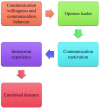Research on the Construction of Emergency Network Public Opinion Emotional Dictionary Based on Emotional Feature Extraction Algorithm
- PMID: 35529545
- PMCID: PMC9072777
- DOI: 10.3389/fpsyg.2022.857769
Research on the Construction of Emergency Network Public Opinion Emotional Dictionary Based on Emotional Feature Extraction Algorithm
Abstract
How to strengthen emergency management and improve the ability to prevent and respond to emergencies is an important part of building a harmonious socialist society. This paper proposes a domain emotion dictionary construction method for network public opinion analysis of public emergencies. Using the advantages of corpus and semantic knowledge base, this paper extracts the seed words based on the large-scale network public opinion corpus and combined with the existing emotion dictionary, trains the word vector through the word2vec model in deep learning, expands the emotion words, and obtains the candidate emotion words according to the semantic similarity calculation, So as to generate a domain emotion dictionary. The accuracy rate of emotion discrimination by the emotion dictionary constructed in this paper is 0.86, the recall rate is 0.92. Through the verification of accuracy and recall rate, the construction method proposed in this paper has good accuracy and reliability. Because of the great differences in different experiences and situations of different groups, there will be great differences in views and perspectives on the same event. The key to prevent the public from blindly following the crowd should be to reach groups close to emotional distance, and targeted prevention and control of public opinion can be conducted according to different characteristics of different groups.
Keywords: algorithm; emergencies; emotional dictionary; emotional feature extraction; internet public opinion.
Copyright © 2022 Hui.
Conflict of interest statement
The author declares that the research was conducted in the absence of any commercial or financial relationships that could be construed as a potential conflict of interest.
Figures








Similar articles
-
Emotion recognition of social media users based on deep learning.PeerJ Comput Sci. 2023 Jun 14;9:e1414. doi: 10.7717/peerj-cs.1414. eCollection 2023. PeerJ Comput Sci. 2023. PMID: 37346659 Free PMC article.
-
A CNN-Based Framework for Predicting Public Emotion and Multi-Level Behaviors Based on Network Public Opinion.Front Psychol. 2022 Jun 23;13:909439. doi: 10.3389/fpsyg.2022.909439. eCollection 2022. Front Psychol. 2022. PMID: 35814112 Free PMC article.
-
Application of edge computing combined with deep learning model in the dynamic evolution of network public opinion in emergencies.J Supercomput. 2023;79(2):1526-1543. doi: 10.1007/s11227-022-04733-8. Epub 2022 Jul 28. J Supercomput. 2023. PMID: 35915780 Free PMC article.
-
Depression Detection on Reddit With an Emotion-Based Attention Network: Algorithm Development and Validation.JMIR Med Inform. 2021 Jul 16;9(7):e28754. doi: 10.2196/28754. JMIR Med Inform. 2021. PMID: 34269683 Free PMC article.
-
Review on Emotion Recognition Based on Electroencephalography.Front Comput Neurosci. 2021 Oct 1;15:758212. doi: 10.3389/fncom.2021.758212. eCollection 2021. Front Comput Neurosci. 2021. PMID: 34658828 Free PMC article. Review.
Cited by
-
Generation paths of online public opinion impact in public health emergency: a fuzzy-set qualitative comparative analysis based on Chinese data.Front Public Health. 2024 Oct 24;12:1404587. doi: 10.3389/fpubh.2024.1404587. eCollection 2024. Front Public Health. 2024. PMID: 39512720 Free PMC article.
-
The formation pattern, causes, and governance of network public opinion on university emergencies.Front Public Health. 2024 Aug 23;12:1367805. doi: 10.3389/fpubh.2024.1367805. eCollection 2024. Front Public Health. 2024. PMID: 39247230 Free PMC article.
References
-
- Ahlem D., Khalil H. (2020). An opinion spread prediction model with twitter emotion analysis during Algeria's Hirak. Comput. J. 3. doi: 10.1093/comjnl/bxaa117 - DOI
-
- Cauley C. E., Block S. D., Koritsanszky L. A., Gass J. D., Frydman J. L., Nurudeen S. M., et al. . (2016). Surgeons' perspectives on avoiding nonbeneficial treatments in seriously ill older patients with surgical emergencies: a qualitative study. J. Palliat. Med. 19, 529–537. doi: 10.1089/jpm.2015.0450, PMID: - DOI - PMC - PubMed
-
- Edens V. (2019). Emergencies and Autism. Public safety communications. 85:41.
LinkOut - more resources
Full Text Sources

